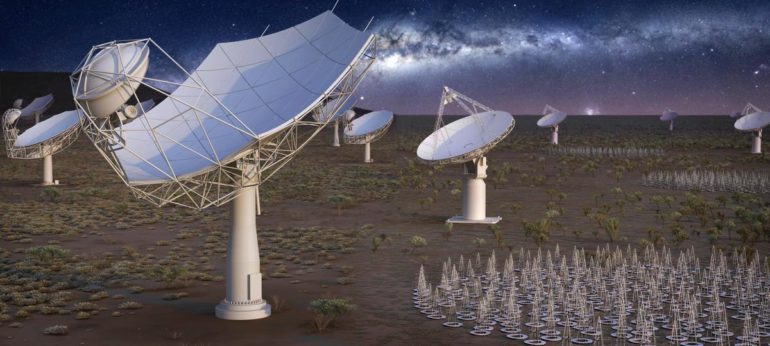An artist’s impression of the SKA at night
Image: SKA
Prime Minister Scott Morrison has made a AU$387 million pledge to meet Australia’s commitments to co-host the Square Kilometre Array (SKA) Observatory.
The SKA project is an international effort to build the world’s largest radio telescope, which will eventually have over a square kilometre of collecting area.
It’s an international project that will consist of thousands of antennas spread across the world, with central cores of operation in South Africa and Western Australia.
The SKA will eventually use thousands of dishes and up to a million low-frequency antennas that will enable astronomers to monitor the sky in unprecedented detail and survey the entire sky much faster than any system currently in existence.
Morrison said the funding, to be delivered over 10 years, would “entrench Australia in this massive partnership”.
“It feeds into this waterfall of data that you have in so many different areas that enable you to interrogate and ensure we can crack some of the biggest problems that are there,” he said. “The quantum computing capability is not just essential for solving deep scientific problems, but it’s absolutely essential for national security.”
Joining Morrison in what was one of his first appearances as Minister for Industry, Science and Technology, Christian Porter said the funding for the SKA forms part of the federal Budget, due to be handed down next month.
“Christian is an absolute science and space junkie on these things, he has the tattoos to prove it,” the prime minister added.
Porter said AU$301.4 million of the injection has been allocated to the construction and operation of the Square Kilometre Array Observatory. AU$64.3 million over 10 years has been allocated to the data processing centre, which will be located at the Pawsey Supercomputing Centre in Western Australia.
The remaining funding will go to site readiness and fibre optic connections.
The money, Porter said, is in effect 14% of the total global commitment, bringing the total amount of funding that has been allocated by the Coalition to AU$710 million.
The project is slated to cost around $1 billion.
Pre-construction development of the SKA started in 2013 and has taken place over a period of seven years. Construction of the SKA begins this year, while routine science observations are expected to start later this decade.
In Australia, the SKA’s low-frequency telescope will initially comprise 512 stations arranged in a large core with three spiral arms, spread over a distance of 65km. Each station will contain 256 individual antennas, representing more than 130,000 antennas in total.
In South Africa, 133 dish antennas will be added to the existing 64-dish MeerKAT precursor telescope, totalling nearly 200 dishes to form the SKA’s mid-frequency telescope array. Most dishes will be concentrated in a core, with three spiral arms extending over 150km.
Organisations from 14 countries are members of the SKA Organisation: Australia, Canada, China, France, Germany, India, Italy, New Zealand, Spain, South Africa, Sweden, Switzerland, The Netherlands, and the United Kingdom. The global organisation is managed by the not-for-profit SKA Organisation, which is headquartered at the Jodrell Bank Observatory, near Manchester in the United Kingdom.



